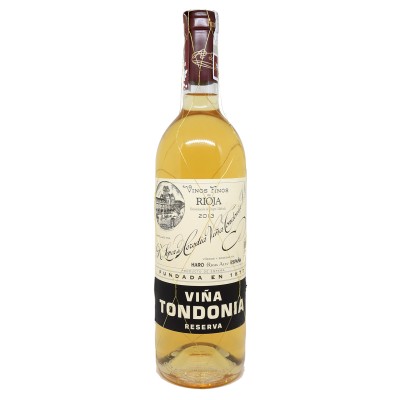Lopez de Heredia - Vina Tondonia Reserva - Blanco 2013
López de Heredia is located in Haro, La Rioja , Spain . Its history began in the mid-19th century when French merchants visited the Rioja region to find alternative sources of quality grapes to make wine, as the phylloxera epidemic had decimated their vineyards. The founder, Don Rafael López de Heredia y Landeta , a knowledgeable and enthusiastic student of the art of winemaking, followed closely in their footsteps. Around 1877, he began the design and construction of the complex that is today known as López de Heredia Bodega, the oldest in Haro and one of the first three bodegas in the Rioja region. The estate produces 4 main vintages; the famous Viña Tondonia (100 hectares), Viña Cubillo (from the 24-hectare vineyard called Viña Cubillas with plots named “La Encina” and “La Monja”), Viña Bosconia (15 hectares from the El Bosque vineyard) and Viña Gravonia (from the 24-hectare Viña Zaconia vineyard).
The grapes are harvested by hand with a curved knife called a “Corquete”, to ensure that the grape skins do not crack. The red grapes are destemmed before going into the fermentation tanks, while the white grapes are crushed, immediately releasing their juice. For rosés, the process is mixed: the skins remain in contact with the must for a period of maceration so that some of the color can be absorbed, but are then removed before fermentation begins. The must is fermented in large oak vats: the largest (with a capacity of 240 hectoliters) are for red wine, while the smallest (capacity of 60 hectoliters) are for whites. A second fermentation takes place in Bordeaux-type oak barrels, and can last up to five or six months. Once the wines have undergone both fermentation processes and the sediment or lees have been removed, the wine is then ready to be aged in 225 litre Bordeaux-sized barrels. The wines then spend a minimum of 6 months aging in the cellar before being released for sale.
Viña Tondonia Reserva Blanc is a blend of Viura (90%) and Malvasia (10%) . It was aged for 6 years in barrels and racked twice a year. 2013 was characterized by abundant rains which, combined with cool temperatures, caused a slight delay in the ripening of the grapes, so that the harvest did not begin until October 7 and ended on October 27, a little earlier than initially planned. On July 12, a hailstorm accompanied by strong winds damaged some bunches of grapes, causing a decrease in the quantity harvested.
Grape varieties: 90% Viura, 10% Malvasia
This item is limited to 1 unit per customer.
Cette référence est réservée aux clients ESTHETE
This exceptional product is available to order online exclusively for our ESTHETE customers.
If you are already a ESTHETE customer, please identify yourself to be able to order it.
If you want to learn more about our rare products and the club, click here.
Learn more





















